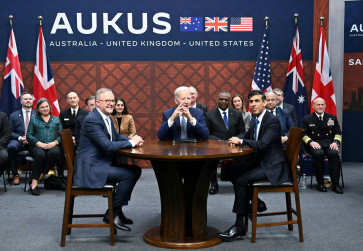Popular Reads
Top Results
Can't find what you're looking for?
View all search resultsPopular Reads
Top Results
Can't find what you're looking for?
View all search resultsHow AUKUS nuclear submarine pact affects Indonesia
The ability for submarines to continue to transit through strategic straits such as the Lombok-Makassar Strait or the Ombai-Wetar Strait, highlights the importance of Jakarta’s control over these waters to be able to defend its sovereign and strategic interests.
Change text size
Gift Premium Articles
to Anyone
The publication of the Australian Defense Strategic Review (DSR) on April 24 has led to little to no comments from Southeast Asian countries. In the DSR, Canberra detailed its strategic ambitions for the years to come, after assessing if the country has “the necessary defence capability, posture and preparedness to best defend Australia and its interests”.
Interestingly, the publication of the DSR came a few weeks after the AUKUS military alliance, composed of Australia, the United Kingdom and the United States, announced on March 13 its four-step plan which is aiming to promote security and a “free and open Indo-Pacific region” by enhancing the alliance capacities and minimizing fragmentation effects in the region.
The first phase of the plan will consist of increased submarine port visits and joint training between the US Navy and the Royal Australian Navy (RAN). The second step will rely on the rotational deployment of the US Navy and the UK’s Royal Navy nuclear-powered submarines (SSNs) to Australia, to accelerate personnel training and establish the bases of a sovereign SSN capability. The next phase involves the proposed sale of three US-made Virginia-class SSNs. Finally, in the late 2030s and early 2040s, brand new SSN-AUKUS will be delivered to the Royal Navy and RAN.
Consequently, the recent development of the AUKUS alliance seems to reflect the seriousness of the Australian Defense Force’s (ADF) ambition to operate at the regional level. One might argue that the ADF position fits as part of a broader strategy to deter China’s hegemonic ambitions and aggressiveness in the region.
Yet, it is no secret that Beijing has increased its military presence in the disputed South China Sea and has allegedly deployed its naval assets in the area, along with unmanned underwater vehicles (UUVs), including within Indonesian territorial waters. Thus, Canberra seeks longer-range military, and more particularly naval, capacities such as the acquisition of SSNs to adopt what has been dubbed in the DSR as a global “defensive approach designed to stop an adversary from succeeding in its goal to coerce states through force, or the threatened use of force, to achieve its dominance”.
All in all, the DSR supports the four-step plan detailed on March 13. Indeed, Virginia-class submarines which are expected to be acquired by RAN are versatile boats, engineered to carry out a wide array of missions. Specifically designed for both littoral and deep-water antisubmarine warfare (ASW) operations, such assets could detect and neutralize enemy submarines and surface warships, while also being used as a power projection and deterrence tool thanks to their capacities to handle land targets with cruise missiles or by deploying the Special Operations Force (SOF).



















